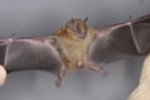Tuesday 21 November 2006
Asian elephant

The
Asian elephant (
Elephas maximus), is one of the three species of elephant. It lives in areas in India, Southeast Asia, including the Indonesian islands of Sumatra and Borneo. It is distinguishable by its smaller size and its smaller ears, compared to African elephants. Small is relative in this case, since the Asian elephant can weigh up to 5000 kilograms and 4 meters in height! Females live in groups, bulls are solitary. The oldest female leads the group and guides their movement in search for food and water. The young hold their mother's or their sister's tail when following the group. If they are in danger, the elephants run with their tails in the air, signalling the other herd members that there is danger. After 15 years, bulls enter sexual maturity, and enter a period called 'musth' each year, in which their testosterone levels soar and they become extemely aggressive. Asian elephants are considered 'endangered' by the IUCN.
Photography by Semnoz, July 2004, licensed under GFDL
You can help spreading the word about this animal by liking it on facebook
Permanent Link
Monday 13 November 2006
Pig-footed Bandicoot

The
Pig-footed Bandicoot (Chaeropus ecaudatus) once lived in Australia, but is now extinct. It ranged from Western Australia, through South Australia and the southern part of the Northern Territory, to southwestern New South Wales and western Victoria in a variety of habitatss. It got its name from their forefeet, which had only two functional toes with hoof-like nails. It became extinct in the 20th century, but before that their numbers were declining through the second part of the 19th century. The cause of their extinction remains unanswered. The most destructive species, foxes and rabbits, were introduced later than their decline started. The most plausible reason of their decline is that with the settlement of Europeans in Australia, their habitat changed by introducing livestock and putting an end to aboriginal land-management. The aboriginals before the Europeans settlers burned small areas to provide fresh, regenerated areas, with a new supply of food.
Picture of a pig-footed bandicoot specimen by Peter Halasz, licensed under GFDL.
Links
IUCN 2004. 2004 IUCN Red List of Threatened Species.
You can help spreading the word about this animal by liking it on facebook
Permanent Link
Sunday 12 November 2006
Donkey or ass

The
donkey or ass (
Equus asinus) is a member of Horse family. Wild donkeys are only found in Northern Africa and the Arabian peninsula and can become 25 to 30 years of age. Predators of the donkey are
lions and
wolves. Donkeys have great sense of self-preservation, hence they will not do anything which will put themselves in any danger. This behavior has resulted in donkeys being called stubborn, although this is the result of the misinterpretation of their behavior. A donkey can be cross-bred with a horse to produce a mule or a hinny. A hinny is the offspring of a male horse and a female donkey (jenny). A mule is the offspring of a male donkey (jack) and a female horse. Both are almost always sterile since horses have 64 chromosomes and donkeys have 62, which results in offspring with an uneven 63 chromosomes.
You can help spreading the word about this animal by liking it on facebook
Permanent Link
Thursday 09 November 2006
The Western Long-beaked Echidna

The
Western Long-beaked Echidna (Zaglossus bruijni) is one of four living species of Echidnas (The Cyclops Long-beaked Echidna was recently discovered). The Western Long-beaked Echidna species live in New Guinea, but earlier fossils indicate that they once also occurred in
Australia. Echidnas are, together with platypuses, the only known mammals that lay eggs. Together, they are placed in the order Monotremata. The difference between the short-beaked echidna and the long-beaked echidna is that the short-beaked eats termites and ants, while the long-beaked echidna eats earthworms. The Western Long-beaked Echidna is listed as endangered by the IUCN. Their main threats are habitat destruction and hunting.
Image licensed under GFDL
You can help spreading the word about this animal by liking it on facebook
Permanent Link
Monday 06 November 2006
Yellow-shouldered Fruit Bat

The
Yellow-shouldered Fruit Bat (Sturnira lilium) lives in the area from northern Mexico to Uruguay, eastern Barzil and northern Argentina. Most yellow shouldered bat males have patches of orange fur over glands on their shoulders, which give the species their name. These glands are also used to attract females. Its diet consists of fruit, insects and pollen. The yellow-shouldered fruit bat is common to abundant.
Image of the yellow shouldered fruit bat by A. Martin, with permission from Regua.co.uk
You can help spreading the word about this animal by liking it on facebook
Permanent Link
Thursday 02 November 2006
Ringtail

The
ringtail (
Bassariscus astutus) is a member of the raccoon family and lives in the mountains, badlands and forests in southwestern United States to Baja California and southern Mexico (
source and range map). It got its name from its black and white striped tail. The ringtail is an agile climber, their ankle joint can turn 180 degrees and can become 7 years of age in the wild. They are most active at dusk and at night, when they feed on insects, squirrels, rodents, rabbits, and occasionally birds, lizards, snakes, frogs, carrion and plants. When ringtails feel threatened, they bristle the hair on its tail, pulling its tail towards its head to look bigger. The scientific Latin name can be translated as cunning little fox.
You can help spreading the word about this animal by liking it on facebook
Permanent Link
 The Asian elephant (Elephas maximus), is one of the three species of elephant. It lives in areas in India, Southeast Asia, including the Indonesian islands of Sumatra and Borneo. It is distinguishable by its smaller size and its smaller ears, compared to African elephants. Small is relative in this case, since the Asian elephant can weigh up to 5000 kilograms and 4 meters in height! Females live in groups, bulls are solitary. The oldest female leads the group and guides their movement in search for food and water. The young hold their mother's or their sister's tail when following the group. If they are in danger, the elephants run with their tails in the air, signalling the other herd members that there is danger. After 15 years, bulls enter sexual maturity, and enter a period called 'musth' each year, in which their testosterone levels soar and they become extemely aggressive. Asian elephants are considered 'endangered' by the IUCN.
The Asian elephant (Elephas maximus), is one of the three species of elephant. It lives in areas in India, Southeast Asia, including the Indonesian islands of Sumatra and Borneo. It is distinguishable by its smaller size and its smaller ears, compared to African elephants. Small is relative in this case, since the Asian elephant can weigh up to 5000 kilograms and 4 meters in height! Females live in groups, bulls are solitary. The oldest female leads the group and guides their movement in search for food and water. The young hold their mother's or their sister's tail when following the group. If they are in danger, the elephants run with their tails in the air, signalling the other herd members that there is danger. After 15 years, bulls enter sexual maturity, and enter a period called 'musth' each year, in which their testosterone levels soar and they become extemely aggressive. Asian elephants are considered 'endangered' by the IUCN. 
 The
The  The
The  The
The  The
The  The
The